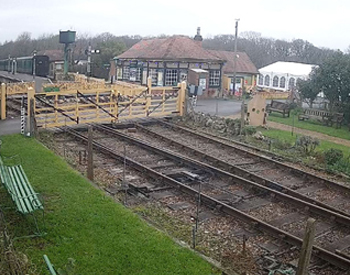Home » The Move
‘The move’
24th January 1971
The move to Havenstreet was reported eloquently by Richard Newman in the Spring 1971 issue of Wight Report. Here is the text verbatim, accompanied by photos published in ‘The Last Train’, the booklet prepared for The Last Train Walk event on 23rd January 2011.
TO HAVEN STREET!
by Richard Newman
At 8.30p.m on 24th January, the last South Western O2 rumbled across the Medina Drawbridge, Newport, high above the river and its quays, ending another transport chapter in the Island’s history, for the rails it ran upon were to be taken up for scrap almost immediately afterwards.
Some 12 hours earlier on that Sunday, we had arrived at Newport Station to find “CALBOURNE” in fine form, standing next to the water column at the Cowes end of the platform. Bob Huxtable and Tom Jackman, of the Loco Dept., had already been working for more than 3 hours to prepare the engine for her historic journeys, and pressure was now building up to a satisfactory level for the move to begin.
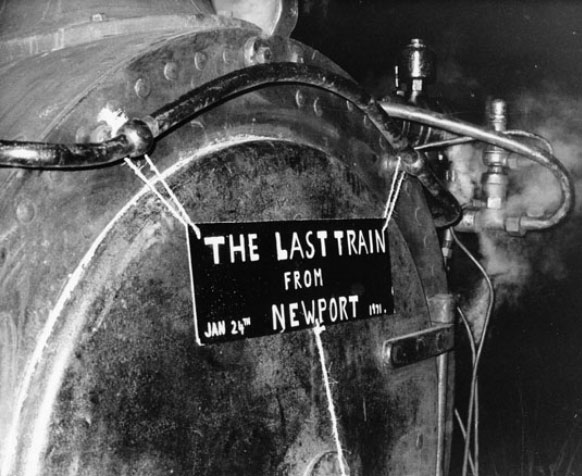
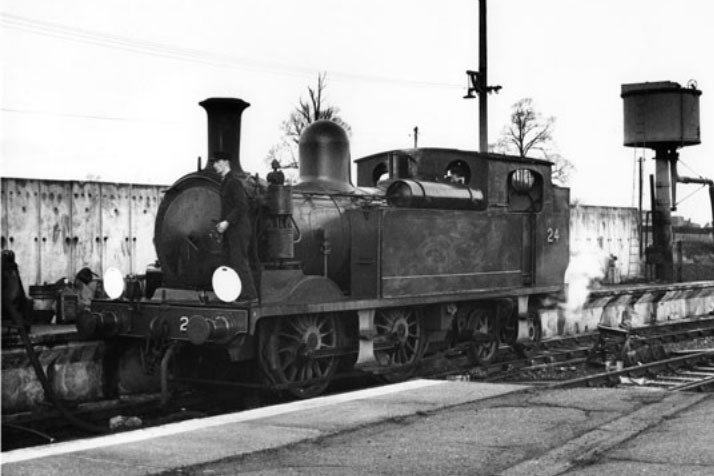
Meanwhile, David Perry and Martyn Mullins, who had been “rostered” as guards during the final preparations made on the previous evening in a well-known Newport hostelry, were preparing the 3 set of former L.B.S.C.R. carriages which were to form the first train of the day. The carriages stood at the northern end of the yard, where they had been moved a couple of weeks previously to facilitate oiling of axle-boxes. George Wheeler, who was appointed in overall charge of the day’s operations, had drawn up an official “Special Notice” for the use of all operating staff, which provided for 4 runs to Haven Street with the engine, together with a couple of additional journeys to be made with the former Ryde Pier Tram.
Consequently, at 10.am. the tram, driven by Terry Hastings and John Wenyon, pulled away from Newport to make an exploratory trip over the disused line, which had been the scene of much activity during the previous days. By this time, crowds had gathered at Newport Station and the Press reporters and photographers were already well-employed taking records of the occasion. Temporary “block posts” were set up for telephone messages to be sent from Haven Street to the Railway Medina public house, Newport, giving the ‘all clear’ for the train to proceed.
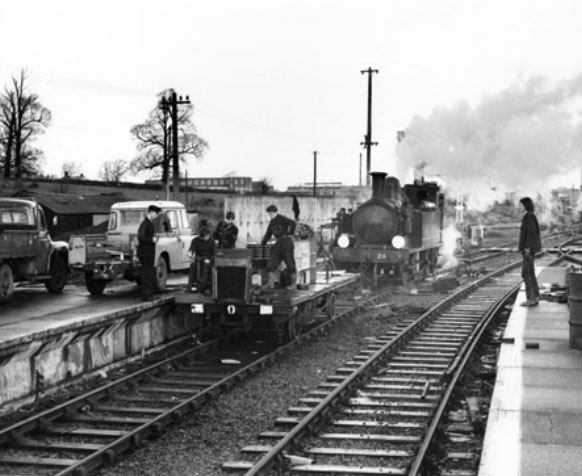
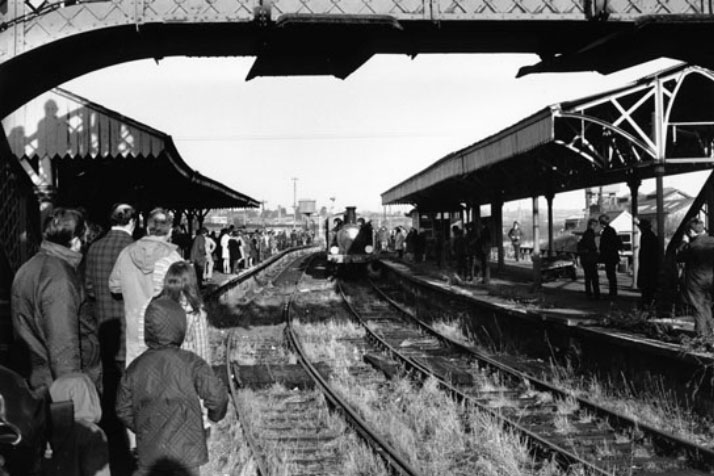
At about 10.40, “CALBOURNE” ran up the yard and coupled up to 3 carriages which were then hauled through the Up platform on to the Viaduct for a preliminary test run, after which water had been taken. As no difficulty was apparent, the train picked up the ‘passengers’ who had been standing patiently on the Down platform. Travel on the train had been restricted to Society members and special guests, and indemnity forms were thus prepared for completion by all who wished to make the journey. Before departure, a small ceremony was held on the platform for Miss Hannah Winter, ardent railway supporter from Haven Street, who was presented with a bouquet by 7-year old Michelle Cobb of Bembridge to commemorate the occasion.
And so, with a blast on the guard’s whistle from David Perry, acknowledged by a “hoot” from the engine, we were away – although slight delay was experienced in persuading a small dog not to stand on the track. As we crossed the viaduct and ran into the tunnel beneath Fairlee Road, it seemed almost as if trains had never stopped running – except for the crowds! At every vantage point along the line, there appeared a sea of faces – mainly local residents of course as the enthusiast world in general had not heard of the manoeuvre. One Society member in Fairlee Road added to the event by displaying a large green flag and Union Jack from his garden! Progress up the bank was excellent – over Halberry House and Mews Lane Crossings & through the avenue of pine trees towards Whippingham to prepare for the steepest gradient of all. Beyond Whippingham, the train passed the horses and cattle in a field later depicted on B.B.C. Television – these creatures had obviously never seen a train before!
As we reached the summit of Wootton Bank, the train was brought to a stand on wet rails in the depths of the damp cutting – which is never penetrated by sunlight in winter. This was done intentionally prior to crossing the slip. Former loco Foreman Ivor Davis and “operating officer” George Wheeler clambered down from the engine and with Terry Hastings and Kim Chalkley, who had positioned themselves at the cutting, they anxiously watched as the engine was coaxed inch by inch past the embankment slip, which had been further swollen by the torrential rain of the previous 24 hours. The engines and carriages were gradually eased over the buckled track, witnessed by further crowds watching from Station Road Bridge.
The most difficult part of the run had been successfully accomplished! From Wootton to Haven Street steam was cut off for the downhill run through the woods and into the station, where another large crowd of people of all age groups eagerly awaited the occasion and it is said that Sunday School attendances suffered badly as a result! Following due ceremony for the Press photographers, the engine took water ready for the return “light” to Newport. The carriages were berthed beyond the road bridge to the east of the station and the engine set off, pausing only for a moment after crossing Wootton slip. What a fine sight it made as it coasted downhill over Halberry House Crossing into Newport, running bunker first into the brilliant winter sunshine.
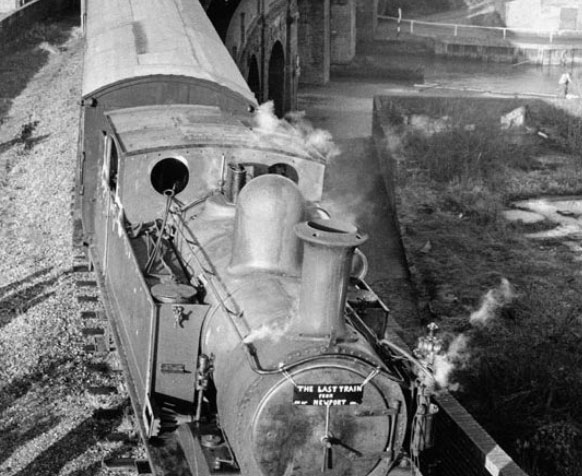
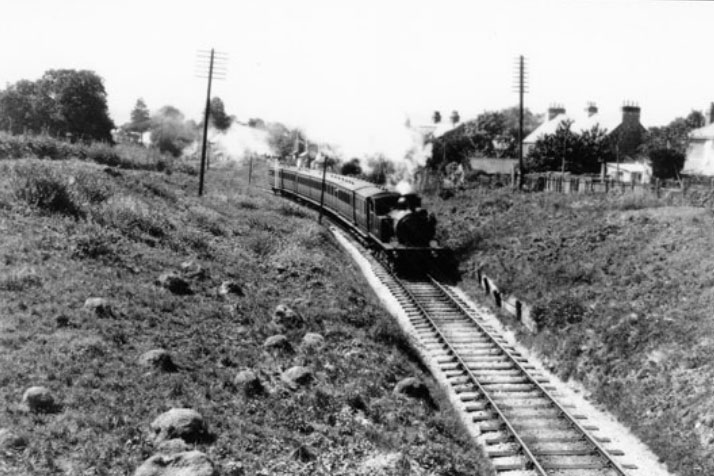
The schedule originally planned had to be revised and it was some time before the next run was made, but the opportunity was taken to marshall the goods wagons into two trains; No. 24, coupled to several loaded coal wagons and the L.S.W.R. Brake Van left Newport at approx. 2.35p.m. carrying on board a despatch bag which contained a letter to Her Majesty The Queen. The document commemorated the fact that this was the last train to call at Whippingham Station, once used by guests of royalty travelling to Osborne House. As the train ground to a halt at Whippingham (closed to passengers in 1953, and now a private residence), Alderman Mark Woodnutt, the Island’s M.P., was waiting to receive the despatch bag from the engine crew (Bob Huxtable and Tom Jackman) and to convey it onwards to Buckingham Palace on the following Tuesday. Society officials posed for photographs on the buffer beam of “CALBOURNE” with Ald. Woodnutt, who was then welcomed aboard the engine for the remainder of the journey to Haven Street.
After some time the engine and Brake Van ambled through the countryside back to Newport. Little time was wasted upon reaching the station however, for daylight was fast fading. At 5.45pm., No. 24 departed from the ‘Up’ platform with three S.E.C.R. carriages well-laden with another load of passengers. Accommodation was strictly limited on this set for No. 4149, the Society’s most recent acquisition, was devoid of all seats, whilst several compartments in the other coaches had been loaded with seat cushions and other miscellanea. A spirited run was made to Haven Street, where, in the darkness, passengers and onlookers one by one drifted away. One carriage (6375) had its electric lighting in working order at the start of the journey, but there was little power in the batteries and the lights grew dimmer as the train proceeded on its way.
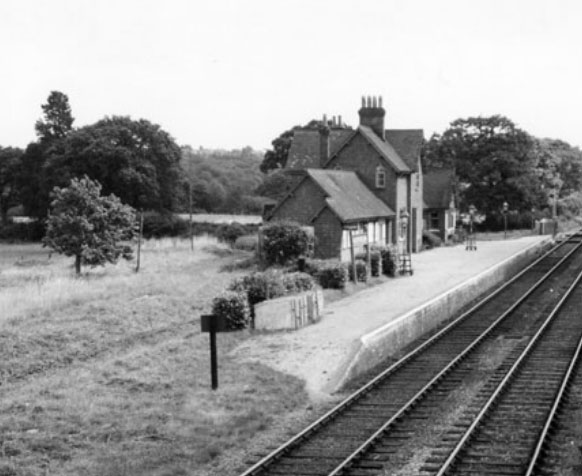
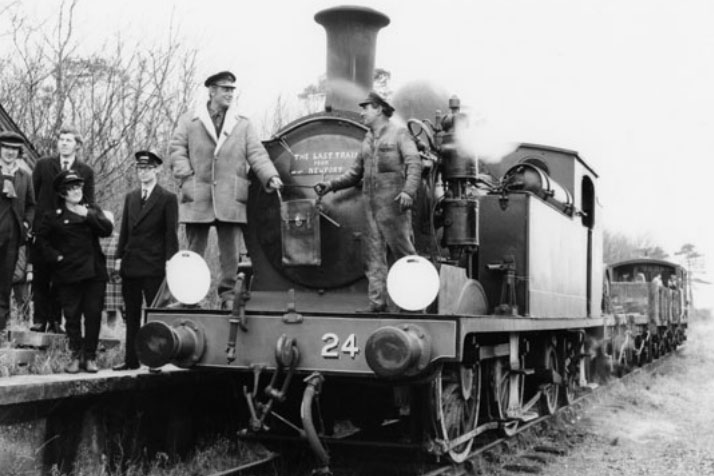
The tram, which had been stationed at Haven Street for most of the day as ‘water carrier’, was sent back to Newport ahead of the engine at this time to collect the remainder of the miscellaneous equipment – which included a platform trolley and the pump used for replenishment of water supplies on the engine. Working on a time interval basis, the engine returned with caution some time later and arrived at Newport just after 7.15pm. to take on water and collect the remaining items – 2 wagons, the 6-wheel Midland crane D429 and its match truck and the 1898 L.S.W.R. van (56046). After engine and tail lamps had been found and placed in position, the train was ready to leave and, at 8.30pm. by the Town Hall clock, the motley assortment of wagons, loaded with a remarkable accumulation of materials, screeched out of the Up platform behind “CALBOURNE”. A small crowd of Society members watched from the platform, cheering the train on its way. A shrill hoot from the engine, followed by a series of long blasts as 24 rumbled over the viaduct ended a 109-year association which the town of Newport had had with its railway since the inauguration of the Cowes & Newport railway in 1862. At this hour of the evening most of the people who had watched the day’s proceedings had been driven home by rain, but two ladies hurried from Quay Street to the Viaduct and waved enthusiastically as the train passed overhead. Still hooting, the engine hauled its load into the tunnel and rushed the steep gradient on the other side.
This was perhaps the most sentimental journey of all – reminiscent of many a solemn ‘Last Day’ – for this was the final train out of Newport; the Society had at last vacated the Island capital. No. 24 made steady progress up the bank, but a stop was made just beyond Mews Crossing to inject. George Wheeler, now acting as guard, walked back along the line to protect the train in accordance with Regulations, for the tram was to follow from Newport some 20 minutes later. As it happened, the tram suffered a mechanical failure on the way and was only coaxed through to Haven Street by Steve Day and John Wenyon after repairs had been carried out using parts of the diesel pump it was carrying! Meanwhile, pressure had again increased on “CALBOURNE” to allow her to proceed. A local resident had thoughtfully provided a Tilley lamp to pinpoint the exact position of the slip at Wootton and had again sanded the wet rails to ease our passage. The vintage crane, formed into this train, was considered to be the next most awkward vehicle to cross the slip by virtue of its 6-wheeled rigid wheelbase but it rode the distorted track in a most satisfactory manner. With an acknowledging hoot, “CALBOURNE” ran downhill as far as the Haven Street distant signal, where a special stop was made to pin down brakes.
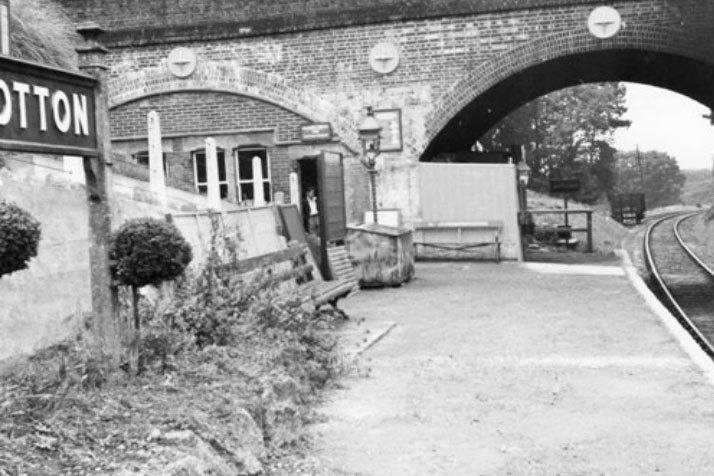
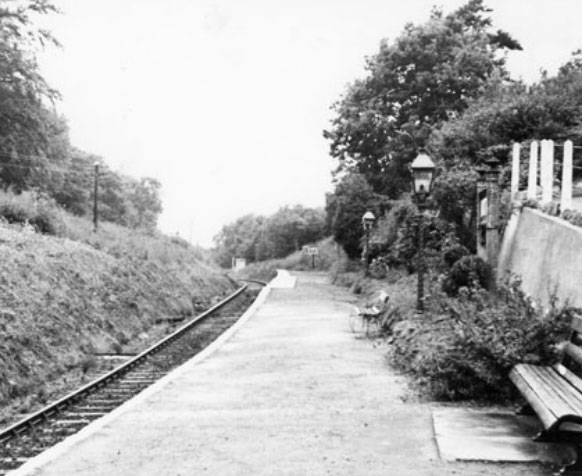
The rainswept woods echoed with the clanging buffers and couplings on the old wagons and the hiss of steam from the engine as the train restarted to run the final few hundred yards into the platform, where another Tilley lamp swung from a post in the wind – a welcome signal through the darkness. At 9.50pm. the train came to a stand at Haven Street, whilst the tram eventually arrived at 10.30pm., having been delayed by its mechanical troubles. Our entry into the ‘White Hart’ public house shortly afterwards, to the strains of suitable “railway” piano music from the resident pianist proved that the villagers of Haven Street would not forget the day that their railway “came back”!!
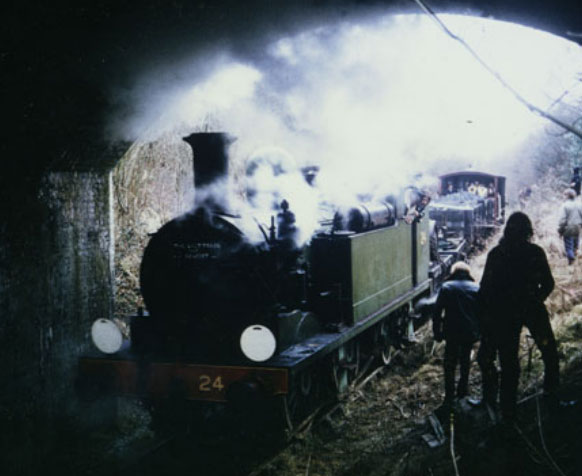
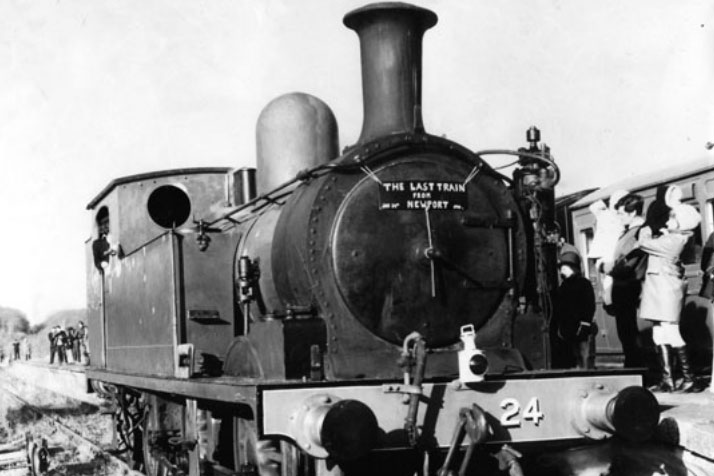
A day which had made history for the Wight Locomotive Society was thus concluded most successfully with the major obstacle, Wootton Embankment Slip, conquered. Local newspapers went to town in their reports of the day’s events – with headlines such as “Scrap Merchants Beaten at Newport” (The News) and “Hundreds Watch Last Trains from Newport” (I.W. County Press). On 2nd February (later than anticipated) three gangs from Messrs. T.W. Ward of Sheffield, the scrap merchants, commenced work from Newport on uplifting the track with alarming speed. By the end of the month rails had been taken out on the Cowes – Wootton and Haven Street – Smallbrook Junction section with only parts of Newport Yard (and of course Haven Street – Wootton) remaining intact. We can not yet be complacent about our present position at Haven Street for capital raising must still continue, but we have achieved what the pessimists said we could never do – establish ourselves at Haven Street Station.
Richard Newman
February 1971
Article first published in Wight Report –
The journal of The Wight Locomotive Society – Spring 1971
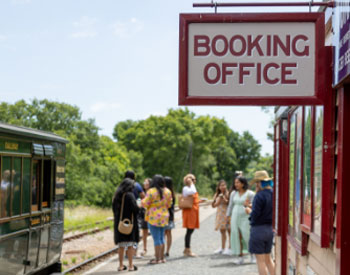
OPENING DAYS + TIMES
Our Havenstreet booking office and station open at 9.30am every day when trains are running…
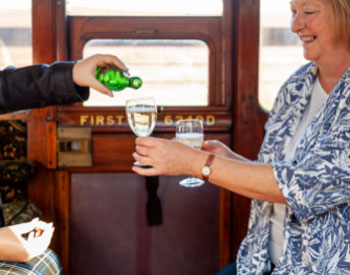
EXCLUSIVE EXPERIENCES
Go on treat yourself, whether you want to be at the coal face with the immersive Footplate Experience or you want absolute luxury…
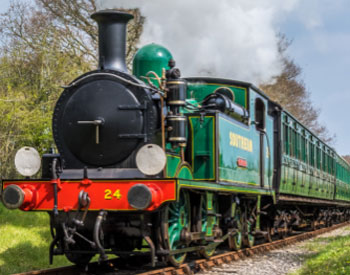
TRAIN RIDES
The Isle of Wight Steam Railway will take you back in time to the heyday of steam, our traditional steam trains…
